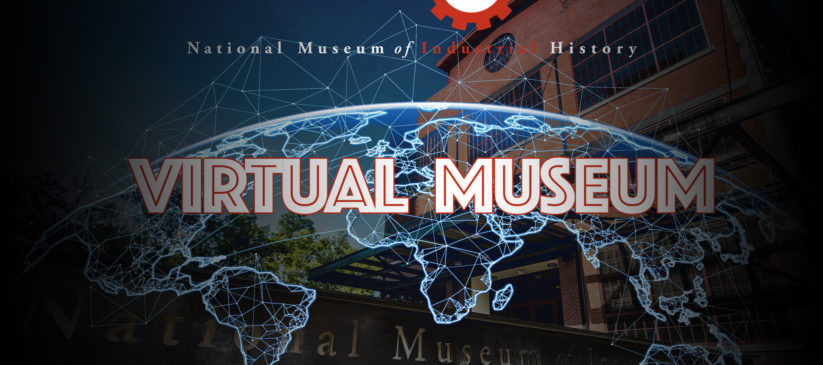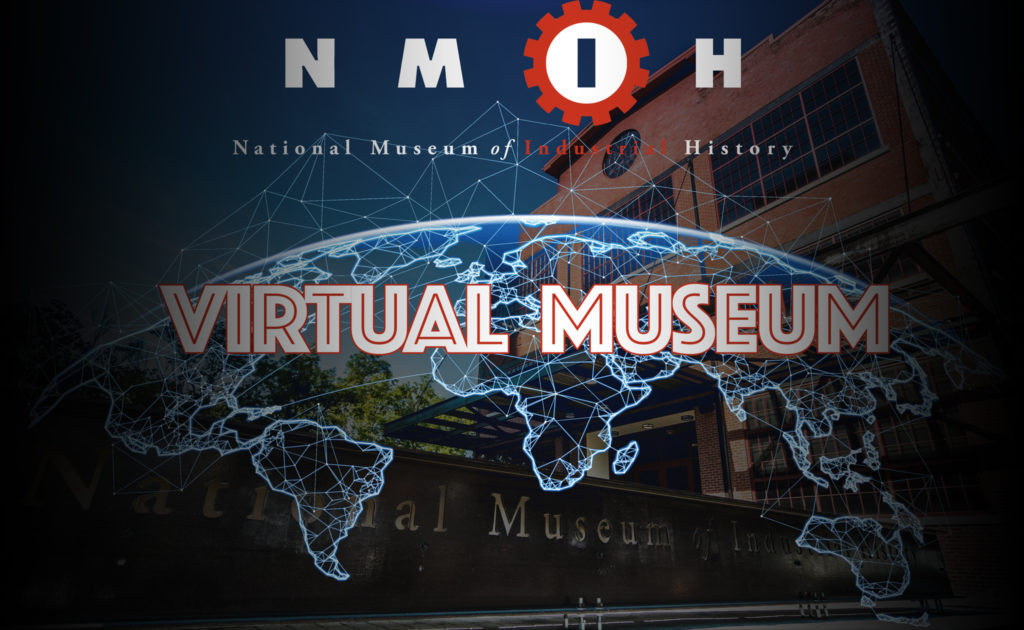
National Museum of Industrial History Launches ‘Virtual Museum’ with Live Programming, Lectures, and More

BETHLEHEM, Pa. – With individuals and families across the nation practicing social distancing and self-quarantine, the National Museum of Industrial History (NMIH) is taking its mission of educating the public about America’s industrial past and inspiring the visionaries of tomorrow online.
The museum is launching a series of live online lectures and presentations, featuring staff from Smithsonian’s National Museum of American History, rare looks inside Martin Tower prior to its implosion from NMIH’s staff photographer, and a fascinating and timely look at how the 1918 influenza pandemic affected Bethlehem Steel and industrial manufacturing. Additional programming includes a daily online ‘industrial story time’ featuring award-winning and New York Times bestselling children’s books focused on industry and architecture.
Virtual patrons can also take a 360 degree tour of the entire museum on Google Maps, a service donated by Bethlehem’s HomeSpot Media. “While it’s no substitute for the real museum experience, we hope this e-tour will give residents of the Lehigh Valley and our fans across the world a little respite in these trying times,” said Glenn Koehler, Director of Marketing and Public Relations at NMIH. The museum is also offering its self-published book, “The Big Green Machine,” about the story and restoration process behind its massive 115-ton Corliss steam engine, in digital format for the first time. For $18 patrons will be able to download the book and receive a physical version shipped to them following the museum’s reopening. One-hundred percent of the proceeds go towards helping the museum recover from the effects of the coronavirus closure.
The museum realizes that millions of businesses and workers are feeling the effects of the current situation right now. As a non-profit museum, we’re no different. We’re deeply grateful for any help provided to the museum during these trying times. Additional ways patrons can help support the museum’s mission include purchasing memberships, shopping in the online gift shop, adopting an artifact, making a gift to the museum’s annual fund, or booking a future event. For a full list of ways you can help the museum, please visit https://www.nmih.org/nmih-
Online Family Industrial Storytime
with Amanda Steele, Family Engagement Manager and Leap Into Science educator at Community Services for Children
Saturday, March 21st at 1PM
Sunday, March 22nd at 7PM
Monday, March 23rd at 10AM
Tuesday, March 24th at 1PM
Wednesday, March 25th at 7PM
Thursday, March 26th at 10AM
Friday, March 27th at 1PM
Saturday, March 28th at 7PM
Sunday, March 29th at 10AM
Monday, March 30th at 1PM
Tuesday, March 31st at 7PM
To see a full list of story time books and how to stream, go to nmih.org/virtualmuseum.
Scheduled live lectures include:
Monday, March 23rd at 2pm
Inside the Demise of Martin Tower with NMIH Director of Marketing and Public Affairs Glenn Koehler
As part of the museum’s staff, Koehler accompanied volunteers, the museum’s curator, and the museum’s historian as they recovered artifacts for the museum’s collection prior to demolition of Bethlehem Steel’s former headquarters in May 2019. This intimate look spans five years of photography, from when the building was still intact to its final, gutted form prior to implosion. His presentation and Q&A will show views and areas few got to see, from the boiler room in the basement of the building to the sweeping vistas as seen from the rooftop.
Tuesday, March 24th at 2pm
Bethlehem Steel, Industry, and the 1918 Influenza Pandemic with James Higgins
102 years ago, the great influenza pandemic swept across the globe, claiming as many as 50 million lives. In the United States, Pennsylvania was hit the hardest. More than 67,000 Pennsylvanians died during the crisis’ most acute phase. This haunting and timely look will examine the virus’s impact on industry, and detail how the then-prosperous Bethlehem Steel helped the community around it suffer some of the lowest mortality rates.
James Higgins is a historian of medicine and concentrates especially on the history of the influenza pandemic in Pennsylvania and Texas. He now lectures at Jefferson University in Philadelphia and Rider University in Lawrenceville, New Jersey.
Thursday, March 26th at 2pm
The President’s Pump with Mark Connar
It is well known that Bethlehem is the home of the first municipal water pumping system in the United States. A replica of this machine is located in its’ original stone building in Historic Bethlehem’s Industrial Quarter. Much less known is that, little more than a century later, the largest steam driven single cylinder stationary water pumping engine in the Americas was erected only a few miles away at a zinc mine in the Upper Saucon Township village of Friedensville. This engine, renowned at the time as The President Engine, was designed and constructed by Cornish engineers using time tested old-world technical know-how coupled with American manufacturing talent. Although not publicly accessible, the remnants of this machine still exist today. This talk will focus on efforts underway to preserve the surviving engine house ruins and to convert the surrounding property into an open-air interpretative museum and heritage park.
Mark W. Connar is a retired businessman with an AB degree in anthropology from Brown University (1972) with post graduate study in archaeology at the University Museum, University of Pennsylvania. He has participated in archeological surveys in the United States and the United Kingdom. He also holds an MBA degree from Lehigh University (1984). He is on the Board of Trustees, Historic Bethlehem Partnership and is a Founding Member of the National Museum of Industrial History. Further, he is a member of the Mine History Association and the Society for Industrial Archeology.
Monday, March 30th at 10am
From the Archives: Mining Photography of George Bretz
Shari Stout from The Smithonian’s National Museum of American History will be presenting an online lecture featuring the historic mining photography of George Bretz. The National Museum of American History is home to an array of mining lamps, hats, and safety equipment, much of it from the anthracite mines of Pennsylvania. In 1884, the Smithsonian displayed a series of photographs taken inside a mine in Pennsylvania by George Bretz, a photographer from Pottsville, PA. Shari will show us some of these photos, talk about the history of these collections, some of the materials collected with them, and the original curator who initiated the photo shoot.
Shari Stout is a collections manager in the Offsite Storage Program at The Smithsonian’s National Museum of American History in Washington, DC, and holds an M.A. in Museum Studies from George Washington University. She has worked at the Smithsonian since 1999, installing exhibitions and caring for a wide range of collections, including the mining collections. Ms. Stout works with everything from glassware to sculpture to locomotives, but specializes in planning and overseeing the movement of the museum’s largest objects. Ms. Stout played a key role in the installation of the Smithsonian collections for the 2016 opening of the National Museum of Industrial History.
Other Programming includes:
Virtual Watch Party: Bethlehem Steel’s Last 20 Years – Building Bridges and Buildings
Saturday, March 28th at 2pm
Join retired Bethlehem Steel Civil Engineer Gordon Baker as he talks about the history of Bethlehem Steel’s bridgemaking operations, which saw some of the world’s most famous structures come from its mills. From the Golden Gate to the Verrazano-Narrows Bridges, Bethlehem Steel helped build it all. Four people from the audience will become part of a live suspension bridge and we will learn how a suspension bridge works.
Gordon Baker worked for twenty years at Bethlehem Steel’s Fabricated Steel Construction Division working on bridges and buildings. During this period, he was a Field Engineer in New York, worked in the Engineering department in Bethlehem, was Assistant Works Engineer in the Leetsdale Pittsburgh plant, and was Superintendent of the large Pittsburgh shop facility. His career included working on two suspension bridges in New York, the Commodore Barry Bridge, Martin Tower, the world’s largest radio telescope in Puerto Rico and numerous other structures. Gordon is a retired Licensed Professional Engineer and a graduate of Lehigh University’s civil engineering program.
Virtual Museum Tour
Virtually visit NMIH with this 360 degree tour that HomeSpot Media graciously did for us back in December. https://goo.gl/maps/
**For best results please view on a laptop or desktop. Mobile users may experience some compatibility issues.**
For more information on how to stream lectures and see additional programming, go to nmih.org/virtualmuseum.
About the National Museum of Industrial History
A Smithsonian Institution-affiliate, the National Museum of Industrial History is dedicated to preserving America’s rich industrial heritage. Housed in an 18,000-square-foot, 100-year-old former Bethlehem Steel facility on the largest private brownfield in America, the Museum is home to exciting exhibits, engaging programs and amazing history. Learn more at nmih.org.
Media Contact:
Glenn Koehler
Director of Marketing and Public Relations
National Museum of Industrial History
[email protected]
610.573.3579 (cell)
Thank you for past Information keeping STEEL HISTORY alive.
Glenn, I want to think you for setting up the NMIH “Virtual Museum”, We have been enjoying your Live Lectures a lot and really hope you will continue them, even after the museum reopens. Many of us are not so luck as to live nearby. We always enjoy topics that include restorations of machinery, and museum behind-the-scenes and industrial areas that would normally be off limits to the public. At the SIA conference in Chicago, y’all did a good talk on getting the water pump back in steam – that would be a good lecture topic. Also, a technological evolution of steel making.
Keep up the good work!
John